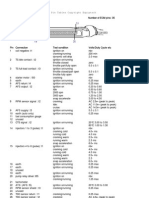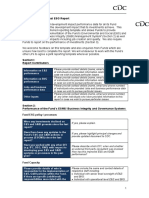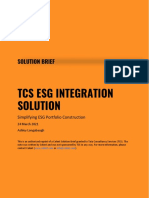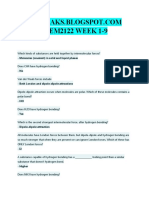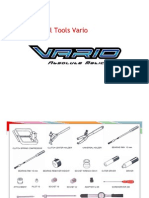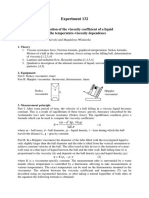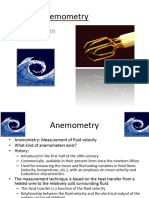GRI Index
GRI Index
Uploaded by
Tarun MajumdarCopyright:
Available Formats
GRI Index
GRI Index
Uploaded by
Tarun MajumdarOriginal Description:
Original Title
Copyright
Available Formats
Share this document
Did you find this document useful?
Is this content inappropriate?
Copyright:
Available Formats
GRI Index
GRI Index
Uploaded by
Tarun MajumdarCopyright:
Available Formats
123
< Previous View
G r I
C o N T E N T
I N D E x
GRI Content Index
This GRI Content Index is provided to assist readers in understanding how our report aligns with the Global Reporting Initiative* (GRI) G3.1 Sustainability Reporting Guidelines. This index includes all Core indicators as well as a number of Additional indicators that we have determined are relevant to our business. We self-declare this report at the A level. For more information about the GRI Guidelines and application levels, visit the GRI web site. GRI Content Index (continued)
Indicator Numbers and Description 1. Strategy and Analysis 1.11.2 Statement from the most senior decision maker; Description of key impacts, risks, and opportunities. Letter From Our CEO; Our Business and Integrated Value Approach (Integrated Value) 3, 5 Status Report Section(s) Page(s) Explanatory Notes
2. Organization Profile 2.12.9 Name of the organization; Primary brands, products, and/or services; Operational structure of the organization; Location of headquarters; Nature of ownership; Markets served; Scale of reporting organization; Significant changes during the reporting period. 2.10 Awards received in the reporting period. 3. Report Parameters 3.13.4 Reporting period; Date of most recent previous report; Reporting cycle; Contact point for questions regarding the report or its contents. 3.5 Process for defining report content. 3.63.8 Boundary of the report; Limitations on scope and/or report boundary; Basis for reporting on joint ventures, subsidiaries, etc. 3.9 Data measurement techniques and the bases of calculations. 3.103.11 Explanation of the effect of any restatements of information provided in earlier reports; Significant changes from previous reporting periods. 3.12 Table identifying the location of standard disclosures in the report.
Covered in the Report Partially Covered in the Report Not Covered in the Report
Integrated Value
Additional details are available in our 2011 Annual Report and Form 10-K.
Integrated Value
22
About This Report Integrated Value About This Report Environment; About This Report About This Report and individual indicator descriptions GRI Index
122 17 122 37, 122 122 Additional information is provided in discussions about indicators throughout the report. No major changes. Some environmental and safety figures have been adjusted. The majority reflect minor changes that occur when new information is received after the close of the data collection period. See also our 2011 Annual Report and Form 10-K.
123
(continues on next page)
2011 Corporate Responsibility Report
124
< Previous View
G r I
C o N T E N T
I N D E x
GRI Content Index (continued)
Indicator Numbers and Description 4. Governance, Commitments, and Engagement 4.14.4 Governance structure of the organization, including committees under the highest governance body; Indication of whether the chair of the highest governance body is also an executive officer; Number of members of the highest governance body that are independent and/or non-executive members. 4.5 Linkage between compensation for members of the highest governance body, senior managers, and executives, and the organizations performance. 4.6 Processes in place for the highest governance body to ensure that conflicts of interest are avoided. 4.7 Process for determining the qualifications and expertise of the members of the highest governance body on economic, environmental, and social (EE&S) topics. 4.8 Internally developed statements of mission or values, codes of conduct, and principles. 4.9 Procedures of the highest governance body for overseeing the organizations identification and management of EE&S performance. 4.10 Processes for evaluating the highest governance bodys own performance, particularly with respect to EE&S performance. 4.11 Explanation of whether and how the precautionary approach or principle is addressed by the organization. 4.12 Externally developed charters, principles subscribed to. Integrated Value; Governance, Ethics, and Public Policy (GE&PP) Environment; Our People GE&PP GE&PP 11, 27 Additional information on Board committees and composition is available in our 2012 Proxy Statement (p 7). Status Report Section(s) Page(s) Explanatory Notes
41, 75
For additional details on our approach to linking pay and performance, see our 2012 Proxy Statement (p 50). Additional information is provided in our 2012 Proxy Statement (p 24). Information on the process for selecting new directors is included in our 2012 Proxy Statement (p 8). A number of directors have expertise in strategic CSR areas of education (Yeary), environment (Hundt), and corporate governance (Yoffie). See also our Governance and Ethics web site.
27 27
Integrated Value; GE&PP; Environment; Supply Chain Integrated Value; GE&PP GE&PP Environment Integrated Value; GE&PP; Environment; Supply Chain GE&PP; Environment; Our People; Supply Chain; Contributions to Society (Society)
10, 28, 39, 87 11, 27 27 38 10, 30, 40, 87 35, 38, 72, 88, 108
See also the charter of the Corporate Governance and Nominating Committee on our Governance and Ethics web site. Additional information is provided in our 2012 Proxy Statement (p 16). Reference is also included in our Intel Code of Conduct. Specific charters/principles are covered in specific sections of the report by topic. Memberships are covered in multiple sections of the report. A list of our major trade association memberships is available on our Report Builder web site.
4.13 Memberships in associations and/or advocacy organizations.
Covered in the Report
Partially Covered in the Report
Not Covered in the Report
(continues on next page)
2011 Corporate Responsibility Report
125
< Previous View
G r I
C o N T E N T
I N D E x
GRI Content Index (continued)
Indicator Numbers and Description 4.144.17 List of stakeholder groups engaged by the organization; Basis for identification and selection of stakeholders; Approaches to stakeholder engagement; Key topics and concerns that have been raised through stakeholder engagement and how the organization has responded to those key topics and concerns, including through its reporting. 5a. Economic Performance Indicators Management Approach Disclosures: Economic EC1 Direct economic value generated and distributed. (Core) EC2 Financial implications and other risks and opportunities for the organizations activities due to climate change. (Core) EC3 Coverage of the organizations defined benefit plan obligations. (Core) EC4 Significant financial assistance received from government. (Core) Integrated Value Integrated Value; Society Integrated Value; Environment Our People Integrated Value 19 19, 102 43 76 19, 21 Additional information is included in our 2011 Annual Report and Form 10-K. Additional information is included in our 2011 Annual Report and Form 10-K (p 22). Climate change risk is also covered in our 2011 Annual Report and Form 10-K (p 10, 18). Additional information is available in our 2011 Annual Report and Form 10-K (p 74). The companys primary use of incentives and grants is for construction of new facilities. These activities are managed on a local level in the location where they are built, and information is usually disclosed by the government/municipality. Additional details on our tax rate and credits are available in our 2011 Annual Report and Form 10-K (p 87). Breakdown of spends by region and information on supplier diversity programs are provided. Our recruiting practices are designed to be inclusive, and we hire from the diverse populations and communities where we operate. A majority of senior management at our global sites are local hires. Status Report Section(s) Integrated Value Page(s) 14 Explanatory Notes
EC6 Policy, practices, and proportion of spending on locally based suppliers at significant locations of operation. (Core) EC7 Procedures for local hiring and proportion of senior management hired from the local community at significant locations of operation. (Core) EC8 Development and impact of infrastructure investments and services provided primarily for public benefit through commercial, in-kind, or pro bono engagement. (Core) EC9 Understanding and describing significant indirect economic impacts, including the extent of impacts. (Additional)
Covered in the Report Partially Covered in the Report Not Covered in the Report
Integrated Value; Supply Chain Our People
96 72
Society
102
Integrated Value
19
(continues on next page)
2011 Corporate Responsibility Report
126
< Previous View
G r I
C o N T E N T
I N D E x
GRI Content Index (continued)
Indicator Numbers and Description 5b. Environmental Performance Indicators Management Approach Disclosures: Environment EN1 Materials used by weight or volume. (Core) Integrated Value; Environment Environment; Supply Chain Environment 11, 38 38, 86 Our systems are not designed to calculate in totality materials in this way. See our Making Silicon Chips web site for a detailed description of the manufacturing process and materials used. Given the complexity and size of our products, calculation of the percentage of recycled content is not applicable; more significant are our efforts in recent years to design out materials such as lead and halogens. See also our Carbon Disclosure Project (CDP) questionnaire response on the CDP web site. Our purchased energy is from multiple public utilities, which include a mix of energy sources. We do not break out total consumption by source. See also our response on the CDP web site. Status Report Section(s) Page(s) Explanatory Notes
EN2 Percentage of materials used that are recycled input materials. (Core)
56
EN3 Direct energy consumption by primary energy source. (Core) EN4 Indirect energy consumption by primary source. (Core)
Environment Environment
45 45
EN5EN7 Energy saved due to conservation and efficiency improvements. (Additional); Initiatives to provide energy-efficient or renewable energy-based products and services. (Additional); Initiatives to reduce indirect energy consumption and reductions achieved. (Additional) EN8EN10 Total water withdrawal by source. (Core); Water sources significantly affected by withdrawal of water. (Additional); Percentage and total volume of water recycled and reused. (Additional) EN11EN12 Location and size of land owned, leased, managed in, or adjacent to protected areas and areas of high biodiversity value. (Core); Description of significant impacts on activities, products, and services on biodiversity in protected areas and areas of high biodiversity value. (Core) EN16EN18 Total direct and indirect greenhouse gas emissions by weight. (Core); Other relevant indirect greenhouse gas emissions by weight (Core); Initiatives to reduce greenhouse gas emissions, and reductions achieved. (Additional) EN19 Emissions of ozone-depleting substances by weight. (Core) EN20 NOx, SOx, and other significant air emissions by type and weight. (Core)
Covered in the Report Partially Covered in the Report Not Covered in the Report
Environment
45
Environment
48, 51
Integrated Value; Environment
42
Major locations and manufacturing sites are listed in this report, and owned and leased facilities are listed in our 2011 Annual Report and Form 10-K (p 19). See also our response on the CDP web site.
Environment
44
Environment Environment
54 54
(continues on next page)
2011 Corporate Responsibility Report
127
< Previous View
G r I
C o N T E N T
I N D E x
GRI Content Index (continued)
Indicator Numbers and Description EN21 Total water discharge by quality and destination. (Core) EN22 Total weight of waste by type and disposal method. (Core) EN23 Total number and volume of significant spills. (Core) EN26 Initiatives to mitigate environmental impacts of products and services, and extent of impact mitigation. (Core) EN27 Percentage of products sold and their packaging materials that are reclaimed by category. (Core) EN28 Monetary value of significant fines and total number of non-monetary sanctions for non-compliance with environmental laws and regulations. (Core) EN29 Significant environmental impacts of transporting products and other goods and materials used for the organizations operations, and transporting members of the workforce. (Additional) 5c. Social Performance Indicators: Labor Practices Management Approach Disclosures: Labor Practices Integrated Value; GE&PP; Our People; Supply Chain Our People Our People 11, 27, 30, 63, 85 66, 67 75 Information is provided on turnover by region and type. Other turnover information is not provided since it is deemed proprietary. Part-time and contract employees have similar access to health and retirement benefits as full-time employees. Benefits related to life insurance, vacation, and tuition reimbursement are prorated for part-time employees. Contract employees are not eligible for a number of benefits, including long-term disability, equity incentive plan, and tuition reimbursement. Parttime and contract employees are not eligible for our sabbatical benefit. The percentage is zero. See also our Human Rights Principles. Status Report Section(s) Environment Environment Environment Environment Environment; Supply Chain Environment Page(s) 49 52 60 55 56, 97 Intel does not have data collection processes to track, record, and report this information in this way. However, an estimated 75% of our packaging material is reusable/recyclable. No major spills were reported in 2011. Other non-compliance issues were reported. Explanatory Notes Additional information is available in SARA Title III Reportable Chemicals by Site.
60
Environment; Supply Chain
44, 98
CO2 emissions of logistics and supply chain and percentage of total CO2 emissions are estimated, and we are developing tools to help improve measurement and tracking of our impacts in this area.
LA1LA2 Total workforce by employment type, employment contract, and region. (Core); Total number and rate of employee turnover. (Core) LA3 Benefits provided to full-time employees that are not provided to temporary or part-time employees, by major operations. (Additional)
LA4 Percentage of employees covered by collective bargaining agreements. (Core)
Covered in the Report Partially Covered in the Report Not Covered in the Report
Our People
31
(continues on next page)
2011 Corporate Responsibility Report
128
< Previous View
G r I
C o N T E N T
I N D E x
GRI Content Index (continued)
Indicator Numbers and Description LA5 Minimum notice period(s) regarding significant operational changes, including whether it is specified in collective agreements. (Core) Status Report Section(s) Our People Page(s) 70 Explanatory Notes We provide advance notice in accordance with local requirements in the different locations where we operate. We also have regular quarterly meetings with all employees via webcast, provide information on business changes as soon as possible, and take steps to mitigate negative impacts. We do not have collective agreements.
LA7 Rates of injury, occupational diseases, lost days, and absenteeism, and number of work-related fatalities by region. (Core) LA8 Education, training, counseling, prevention, and risk control programs in place to assist workforce members, their families, or community members regarding serious diseases. (Core) LA10LA11 Average hours of training per year per employee, by employee category. (Core); Programs for skills management and lifelong learning that support continued employability. (Additional) LA12 Percentage of employees receiving regular performance and career development reviews. (Additional) LA13 Composition of governance bodies and breakdown of employees by category according to gender, age group, minority group membership, and other indicators of diversity. (Core) LA14 Ratio of basic salary of men to women by employee category. (Core)
Our People Our People
81 79, 82
Our People
69
Our People Our People
68 73
Our People
74
Overall ratio is not reported due to information being deemed proprietary, but breakdown of top 50 in senior management is reported in terms of compensation.
LA15 Return to work and retention rates after parental leave. (Core) 5d. Social Performance Indicators: Human Rights Management Approach Disclosures: Human Rights HR1 Percentage and total number of significant investment agreements that include human rights clauses or that have undergone human rights screening. (Core) HR2 Percentage of significant suppliers and contractors that have undergone screening on human rights and actions taken. (Core)
Covered in the Report Partially Covered in the Report Not Covered in the Report
Our People
77
Integrated Value; GE&PP; Supply Chain Supply Chain
11, 30, 85 30 Our comprehensive site selection process evaluates several criteria, including human and labor rights considerations. Supplier contracts also include requirements.
Supply Chain
90
(continues on next page)
2011 Corporate Responsibility Report
129
< Previous View
G r I
C o N T E N T
I N D E x
GRI Content Index (continued)
Indicator Numbers and Description HR3 Total hours of employee training on policies and procedures concerning aspects of human rights that are relevant to operations, including the percentage of employees trained. (Additional) HR4 Total number of incidents of discrimination and actions taken. (Core) Status Report Section(s) GE&PP; Supply Chain Page(s) 28, 88 Explanatory Notes Training on the Intel Code of Conduct and other policies and procedures is mandatory for every Intel employee and includes content on human rights and our Human Rights Principles. Results, while compiled for internal review and action, are not currently publicly reported since this information is deemed proprietary. Information on approach to diversity and ethics and compliance is reported. GE&PP; Our People; Supply Chain 30, 65, 91 We operate in a number of countries identified by stakeholders as being at higher risk for labor concerns. We conduct regular Intel Code of Conduct training, which also covers our Human Rights Principles in place. We have not identified any Intel operations with significant risk for child labor or forced or compulsory labor.
HR5HR7 Operations identified in which the right to exercise freedom of association and collective bargaining may be at significant risk, and actions taken to support these rights. (Core); Operations identified as having significant risk for incidents of child labor, or forced or compulsory labor, and measures taken to contribute to the elimination of child labor. (Core) HR10HR11 Percentage and total number of operations that have been subject to human rights assessments and number of grievances resolved. (Core) 5e. Social Performance Indicators: Society Management Approach Disclosures: Society SO1 Nature, scope, and effectiveness of any programs and practices that assess and manage the impacts of operations on communities, including entering, operating, and exiting. (Core) SO2SO3 Percentage and total number of business units analyzed for risks related to corruption. (Core); Percentage of employees trained in organizations anti-corruption policies and procedures. (Core) SO4 Actions taken in response to incidents of corruption. (Core)
GE&PP; Our People; Supply Chain
30, 65, 91
Integrated Value; Society Integrated Value; Society GE&PP
11, 102 14, 102
28
GE&PP
28
Data is reported on anti-corruption training and assessment processes. Summary types of findings from our ECOC and typical actions taken are also provided. We do not provide detailed information on specific actions taken since this information is deemed proprietary.
SO5SO6 Public policy positions and participation in public policy development and lobbying. (Core); Total value of financial and in-kind contributions to political parties, politicians, and related institutions by country. (Additional)
Covered in the Report Partially Covered in the Report Not Covered in the Report
GE&PP
33
(continues on next page)
2011 Corporate Responsibility Report
130
< Previous View
G r I
C o N T E N T
I N D E x
GRI Content Index (continued)
Indicator Numbers and Description SO7SO8 Total number of legal actions for anti-competitive behavior, anti-trust, and monopoly practices and their outcomes. (Additional); Monetary value of significant fines and total number of non-monetary sanctions. (Core) SO9SO10 Operations with significant potential or actual impact on local communities and prevention/mitigation activities. (Core) 5f. Social Performance Indicators: Product Responsibility Management Approach Disclosures: Product Responsibility PR1 Life-cycle stages in which health and safety impacts of products and services are assessed for improvement. (Core) PR3 Type of product and service information required by procedure, and percentage subject to such requirements. (Core) PR5 Practices related to customer satisfaction, including results of surveys measuring customer satisfaction. (Additional) PR6 Programs for adherence to laws, standards, and voluntary codes related to marketing communications, including advertising. (Core) PR8 Total number of substantiated complaints regarding breaches of customer privacy and losses of customer data. (Additional) PR9 Monetary value of significant fines for non-compliance with laws and regulations concerning the provision and use of products and services. (Core)
Covered in the Report Partially Covered in the Report Not Covered in the Report
Status
Report Section(s) GE&PP
Page(s) 29
Explanatory Notes See also the Competition in the Innovation Economy web site and our 2011 Annual Report and Form 10-K (p 89).
Integrated Value; Environment; Society
14, 42, 102
Integrated Value; GE&PP; Environment Environment Environment; Supply Chain Integrated Value; Our People GE&PP
11, 32, 55 38 55, 90 9, 21, 75 27 32
Product responsibility topics span multiple sections of the report. For more information, refer to the Intel Quality System Handbook. We also provide our customers with information on the energy efficiency of our products through our web site and publications on our web site. For more information, refer to the Intel Quality System Handbook. Covered in the Intel Code of Conduct and in our 2011 Annual Report and Form 10-K (p 90). Total number not reported, but information is available on Intels Privacy Policy and on our Public Policy web site. Information on legal proceedings is included in our 2011 Annual Report and Form 10-K (p 89).
2011 Corporate Responsibility Report
You might also like
- Bosch 35 Pin Early Motronic Pinout (BMW 5,6,7)Document2 pagesBosch 35 Pin Early Motronic Pinout (BMW 5,6,7)Posada Burgueño Carlos67% (3)
- Esg Policy TemplateDocument13 pagesEsg Policy Templatemanish026100% (1)
- Double MaterialityDocument18 pagesDouble MaterialityShadab AlamNo ratings yet
- MPR PPT EsgDocument12 pagesMPR PPT EsgSandeep ShuklaNo ratings yet
- GRI Professional Certification PresentationDocument17 pagesGRI Professional Certification PresentationKeyur Joshi0% (1)
- Print Version - 1998-2002 Smart City-Coupe - Fortwo (A450, C450) Fuse Box DiagramDocument4 pagesPrint Version - 1998-2002 Smart City-Coupe - Fortwo (A450, C450) Fuse Box DiagramCarlos Andrade0% (1)
- Danone Exhaustive Extra-Financial 2018 DataDocument23 pagesDanone Exhaustive Extra-Financial 2018 DatashamimshawonNo ratings yet
- ESG Steering Committee CharterDocument2 pagesESG Steering Committee Charterkeyice100% (2)
- ESG Assessment Methodology Executive Summary: Vigeo - Eiris, An Affiliate of Moody'SDocument14 pagesESG Assessment Methodology Executive Summary: Vigeo - Eiris, An Affiliate of Moody'SJosua Evan100% (1)
- ESG Assignment Part 2: Shareholder ActivismDocument6 pagesESG Assignment Part 2: Shareholder ActivismParesh ShrivastavaNo ratings yet
- Live Work Maintenance PracticesDocument5 pagesLive Work Maintenance PracticesTarun Majumdar0% (1)
- Design Drawings ChecklistDocument22 pagesDesign Drawings ChecklistMasrizal RamlyNo ratings yet
- Materiality and Sustainability Disclosure - SGX Top50 - Ernst & Young Thought Leadership Oct2015Document20 pagesMateriality and Sustainability Disclosure - SGX Top50 - Ernst & Young Thought Leadership Oct2015Krishna SadashivNo ratings yet
- Sustainability Reporting Frameworks 2023Document39 pagesSustainability Reporting Frameworks 2023Mohsin Khan100% (1)
- The Challenge of Rating ESG PerformanceDocument3 pagesThe Challenge of Rating ESG PerformanceRayhan AriqNo ratings yet
- 2021 DFGE EcoVadis Eng Web PDFDocument2 pages2021 DFGE EcoVadis Eng Web PDFDFGE – Institute for Energy, Ecology and EconomyNo ratings yet
- BSEs Guidance Doc On ESGDocument12 pagesBSEs Guidance Doc On ESGsantoshjayanti100% (1)
- Ecovadis Reassessment QuestionnaireDocument14 pagesEcovadis Reassessment QuestionnaireirsoheibNo ratings yet
- Esg Reporting Index 202Document121 pagesEsg Reporting Index 202Maja ZmajNo ratings yet
- Endroof ESG Sustainability PolicyDocument8 pagesEndroof ESG Sustainability Policyjoseph koigiNo ratings yet
- CEO Guide To ESG ReportingDocument19 pagesCEO Guide To ESG ReportingDaniel nemeses Espina100% (1)
- Progress Through Partnership 2013 Esg and Citizenship Report Progress Through Partnership 2013 Esg and Citizenship ReportDocument55 pagesProgress Through Partnership 2013 Esg and Citizenship Report Progress Through Partnership 2013 Esg and Citizenship ReportsupersethNo ratings yet
- UKELA Junior Moot Appellant SkeletonDocument6 pagesUKELA Junior Moot Appellant SkeletonBence O. Leb100% (1)
- Morgan Stanley Institute For Sustainable Investing-2024 Sustainable Signals CorporatesDocument19 pagesMorgan Stanley Institute For Sustainable Investing-2024 Sustainable Signals CorporatesSustenomics100% (1)
- ESG - Double MaterialityDocument12 pagesESG - Double Materialityphuong.sropsNo ratings yet
- Methodology 12-04-23Document18 pagesMethodology 12-04-23alcy2793No ratings yet
- CPgroup - Materiality Assessment Report 2021 enDocument11 pagesCPgroup - Materiality Assessment Report 2021 enNguyen DuyNo ratings yet
- CDC Annual ESG Report TemplateDocument6 pagesCDC Annual ESG Report TemplateJean OlemouNo ratings yet
- SP ESG Indices WebDocument21 pagesSP ESG Indices WebRohan AgrawalNo ratings yet
- PMI REPORT-10-takeaways-pmi-integrated-report-2022Document1 pagePMI REPORT-10-takeaways-pmi-integrated-report-2022bryanleekietNo ratings yet
- CDP BRSR Report LowResDocument19 pagesCDP BRSR Report LowResGokul KrishnanNo ratings yet
- Ecovadis SurveyDocument17 pagesEcovadis SurveyAna MNo ratings yet
- Infosys Esg Diversity and InclusionDocument3 pagesInfosys Esg Diversity and InclusionSundareshwer SNo ratings yet
- ESG Risk Rating PDF Sample Company Report PDFDocument5 pagesESG Risk Rating PDF Sample Company Report PDFMohdshariqNo ratings yet
- Corruption and ISO 37001Document10 pagesCorruption and ISO 37001Khaled Haddad100% (1)
- Sample Questionnaire 2 Sustainability AssessmentDocument137 pagesSample Questionnaire 2 Sustainability AssessmentGaurav Shastri100% (2)
- ESDD CSR Assessment Draft 20apr2017Document45 pagesESDD CSR Assessment Draft 20apr2017Ngo TungNo ratings yet
- CSR Is A Win-Win Opportunity For Companies, Financial Investors and Society at LargeDocument9 pagesCSR Is A Win-Win Opportunity For Companies, Financial Investors and Society at LargeSumit GuptaNo ratings yet
- ESG Scores Firm PerformanceDocument108 pagesESG Scores Firm PerformanceArran PickwickNo ratings yet
- Kpis - For Esg - European Federation of Financial Analysts Societies - 5314Document70 pagesKpis - For Esg - European Federation of Financial Analysts Societies - 5314Camilo DiasNo ratings yet
- Guide For Suppliers Ext EnvDocument19 pagesGuide For Suppliers Ext EnvLuis APNo ratings yet
- ESG Roadmap To Resilience How To Innovate and Thrive During A Global CrisisDocument10 pagesESG Roadmap To Resilience How To Innovate and Thrive During A Global CrisisMaria Rona SilvestreNo ratings yet
- A Practical Guide To Sustainability Reporting Using GRI and SASB StandardsDocument42 pagesA Practical Guide To Sustainability Reporting Using GRI and SASB StandardsSetiani Putri100% (1)
- Key Takeaways: October 23, 2018 October 23, 2018Document20 pagesKey Takeaways: October 23, 2018 October 23, 2018Basanth0% (1)
- Verizon 2021 ESG ReportDocument95 pagesVerizon 2021 ESG ReportSabariNo ratings yet
- BRSR Handbook by OrenDocument20 pagesBRSR Handbook by Orenburhanuddinsaify100% (1)
- Assurance Engagement - ISAE 3000Document19 pagesAssurance Engagement - ISAE 3000Daniel DadaNo ratings yet
- International Framework of CSRDocument20 pagesInternational Framework of CSRSahil BhoreNo ratings yet
- Sustainability Reporting Playbook Final 16032023Document37 pagesSustainability Reporting Playbook Final 16032023AlokaNofisinaNo ratings yet
- ESG Risk Methodology May2021Document54 pagesESG Risk Methodology May2021aleksandar.kamenjasevicNo ratings yet
- Bringing Carbon To BaseDocument15 pagesBringing Carbon To BaseVikram T100% (1)
- DFGE-Ecovadis Services ENGDocument2 pagesDFGE-Ecovadis Services ENGDFGE – Institute for Energy, Ecology and EconomyNo ratings yet
- Esg Reporting Guide Final EngDocument30 pagesEsg Reporting Guide Final Engsouffl3.lnickNo ratings yet
- Sustainability Report GRI StandardDocument34 pagesSustainability Report GRI StandardRaditya ShintaNo ratings yet
- Esg Evolution and Best Practice A Practical Guide To Corporate ReportingDocument60 pagesEsg Evolution and Best Practice A Practical Guide To Corporate ReportingKan WAI LEONG100% (3)
- Webinar Getting Started With Scope 1 2 Carbon Emissions SlidesDocument69 pagesWebinar Getting Started With Scope 1 2 Carbon Emissions Slidestankeanleong100% (1)
- The Reality of MaterialityDocument41 pagesThe Reality of MaterialityComunicarSe-ArchivoNo ratings yet
- SASB Conceptual FrameworkDocument25 pagesSASB Conceptual FrameworkMohammad Yunus SalehiNo ratings yet
- CSRD Fact SheetDocument6 pagesCSRD Fact Sheetsameeksha nsNo ratings yet
- ESG Normative Landscape - v0.2Document124 pagesESG Normative Landscape - v0.2Prasanth Kumar SahukariNo ratings yet
- Sustainability Reporting and Human RightsDocument30 pagesSustainability Reporting and Human RightsComunicarSe-ArchivoNo ratings yet
- lTIIA ESG HandbookDocument94 pageslTIIA ESG HandbookEmdad Yusuf100% (1)
- ESG Integration Solution InformationDocument12 pagesESG Integration Solution InformationVenki EdeNo ratings yet
- Adis Final Syllabus PDFDocument29 pagesAdis Final Syllabus PDFTarun MajumdarNo ratings yet
- Maths Addition AssignmentDocument5 pagesMaths Addition AssignmentTarun MajumdarNo ratings yet
- Class-2 Subject-Science Assignment: Chapter-Bones and MusclesDocument9 pagesClass-2 Subject-Science Assignment: Chapter-Bones and MusclesTarun MajumdarNo ratings yet
- English Assignment Class IiDocument9 pagesEnglish Assignment Class IiTarun MajumdarNo ratings yet
- Aditya Academy Syllabus-II 2020Document7 pagesAditya Academy Syllabus-II 2020Tarun MajumdarNo ratings yet
- Mock DrillDocument2 pagesMock DrillTarun MajumdarNo ratings yet
- Go To MoviesDocument3 pagesGo To MoviesTarun MajumdarNo ratings yet
- Tanu WritingDocument5 pagesTanu WritingTarun MajumdarNo ratings yet
- Guidelines For Pre-Monsoon ActivityDocument14 pagesGuidelines For Pre-Monsoon ActivityTarun Majumdar40% (5)
- Glosario BitcoinDocument23 pagesGlosario BitcoinPlanifica Tus Finanzas100% (1)
- Books List For CSPDocument1 pageBooks List For CSPTarun Majumdar0% (1)
- Cluster Link Name Link ID Vender Name Engineer Name: Sheet1Document3 pagesCluster Link Name Link ID Vender Name Engineer Name: Sheet1Tarun MajumdarNo ratings yet
- PHAST PresentationDocument81 pagesPHAST PresentationTarun Majumdar75% (4)
- Instructions To View/Downlad Ignou Study Material: 1. For RegistrationDocument1 pageInstructions To View/Downlad Ignou Study Material: 1. For RegistrationTarun MajumdarNo ratings yet
- Laws On Industrial SafetyDocument86 pagesLaws On Industrial SafetyTarun Majumdar100% (1)
- The Pinch AnalysisDocument7 pagesThe Pinch AnalysisAdriana WagnerNo ratings yet
- Plug and Ball CatcherDocument48 pagesPlug and Ball CatcherDoni KurniawanNo ratings yet
- (AMALEAKS - BLOGSPOT.COM) CHEM2122 Week 1-9Document15 pages(AMALEAKS - BLOGSPOT.COM) CHEM2122 Week 1-9Jason NeighNo ratings yet
- Special Tools VarioDocument20 pagesSpecial Tools VarioHariri Priyanto100% (2)
- Toyota Forklift 8FGF, FDF15-30 Shop ManualDocument1,070 pagesToyota Forklift 8FGF, FDF15-30 Shop ManualStig OldervikNo ratings yet
- Tabel Loading & Mtcroad DH - 2021Document37 pagesTabel Loading & Mtcroad DH - 2021Ardiansyah SatrionoNo ratings yet
- Lasers - Principles: (Laser Pointer - This Photo Was Provided by Physics World)Document6 pagesLasers - Principles: (Laser Pointer - This Photo Was Provided by Physics World)narendra.it12No ratings yet
- A 320Document2 pagesA 320Diego CascanteNo ratings yet
- Lighting Lighting: Essential Smartbright LEDDocument2 pagesLighting Lighting: Essential Smartbright LEDAndi RamaNo ratings yet
- JSS1 Combined 3RD Term Scheme of WorkDocument15 pagesJSS1 Combined 3RD Term Scheme of Workojo ayodeji johnsonNo ratings yet
- SC Project Closeout Report v6Document27 pagesSC Project Closeout Report v6SateeshIngoleNo ratings yet
- Experiment 132: Determination of The Viscosity Coefficient of A Liquid and The Temperature-Viscosity DependenceDocument3 pagesExperiment 132: Determination of The Viscosity Coefficient of A Liquid and The Temperature-Viscosity DependenceMphoentle MaleboNo ratings yet
- GGASS Investor Presentation 3-09Document14 pagesGGASS Investor Presentation 3-09api-1158549167% (3)
- Robotarm II G-Series Pneumatic Hydraulic ActuatorsDocument8 pagesRobotarm II G-Series Pneumatic Hydraulic ActuatorsYuri Soverika SitepuNo ratings yet
- ZDA Spotlight: January 2010Document6 pagesZDA Spotlight: January 2010Chola MukangaNo ratings yet
- Copper Water and Gas Tube According ASTM B 88 - Imperial UnitsDocument3 pagesCopper Water and Gas Tube According ASTM B 88 - Imperial UnitsecsuperalNo ratings yet
- Operation Maintenance SOWDocument8 pagesOperation Maintenance SOWKiki Iswadi PrajamanggalaNo ratings yet
- Procedure de Test BOPDocument12 pagesProcedure de Test BOPkhireddineboulifaNo ratings yet
- Electronic Fuel Viscosity Controller New Model English Tib 771 GB 0215Document50 pagesElectronic Fuel Viscosity Controller New Model English Tib 771 GB 0215irfanWPK100% (2)
- Nucl - Phys.B v.711Document617 pagesNucl - Phys.B v.711buddy72No ratings yet
- Hot-Wire AnemometryDocument25 pagesHot-Wire Anemometrymerrouche.mohamed99No ratings yet
- Variador StepDocument203 pagesVariador Stepgosx13No ratings yet
- Proposed Per KM Rates For The Transportation of The Tourists in Sri LankaDocument4 pagesProposed Per KM Rates For The Transportation of The Tourists in Sri LankaHarshika WijerathnaNo ratings yet
- Carrier Multi Split Brochure AU LRDocument8 pagesCarrier Multi Split Brochure AU LRFady WagiehNo ratings yet
- Medidor ElectromagneticoDocument22 pagesMedidor Electromagneticocbanegas1983No ratings yet
- Moment of Truth EYDocument44 pagesMoment of Truth EYCud PhNo ratings yet
- LPG Loading Procedure'sDocument15 pagesLPG Loading Procedure'sSayed Abo ElkhairNo ratings yet
